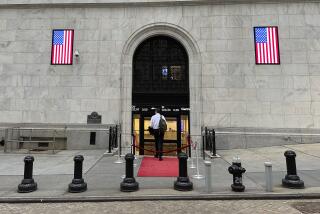Japanese Agree to Buy More U.S. Semiconductors : Chips: In an effort to salvage a 1991 agreement, a trade group also pledges to supply U.S. vendors with advanced data on purchase requirements.
- Share via
TOKYO — In what appeared to be a last-ditch effort to avert a looming trade crisis with the United States, Japan’s electronics industry agreed Thursday to “emergency measures” to boost purchases of foreign semiconductors, including providing U.S. vendors with advanced information on Japan’s chip requirements.
Under the agreement, the Electronic Industry Assn. of Japan promised that its 10 largest members--which together account for half of Japan’s $20 billion a year in chip purchases--will take the unusual step of providing, six months in advance, lists specifying the types and volume of chips they will purchase.
Such information, the association said after trade talks with a delegation of the U.S. Semiconductor Industry Assn., will enable U.S. vendors to more aggressively market their products, and the Japanese, in turn, promised to aggressively buy American whenever possible.
The Japanese association also pledged to seek commitments from each of its 62 member companies to observe the semiconductor trade pact, promote purchases of high-value custom-designed foreign chips and increase foreign orders at a rate greater than the overall expansion of demand when Japan’s economy recovers.
U.S. industry executives hammered out the deal with their Japanese counterparts in an effort to salvage a 1991 chip agreement that called for Japan to make its market more accessible to outside vendors and to boost foreign market share to at least 20%. In 1991, foreign vendors held 14.4% of Japan’s market--virtually the same share as in 1989.
Japanese negotiators Thursday continued to reject the notion that they were obliged to grant American chip makers a 20% share. However, they appeared to have retreated from the more defiant position expressed last week when Japanese executives insisted that they were doing all they could to open their market and would have nothing new to offer the visiting American delegation.
Shinichi Itoh, executive vice president at NEC Corp. and chairman of the User’s Committee of Foreign Semiconductors, said the new accord would accelerate progress toward the 20% goal. “We have high confidence that these extraordinary measures will result in significant increases in the (foreign) market share.”
Industry observers, however, were highly skeptical of how quickly Japanese companies can boost foreign purchases in the midst of a recession. The large electronics companies are themselves chip makers and have expensive semiconductor manufacturing equipment lying idle. The companies have suffered a string of poor earnings reports and would have to swallow further huge losses in order to redirect orders from their own chip divisions to foreign suppliers.
American chip makers say they have remained firm on increasing market share in Japan because they cannot be competitive in the world market unless they can have equal access in Japan--the world’s largest semiconductor market. They argue that they lose $1 billion a year in sales in Japan because of exclusive Japanese business practices that limit U.S. market share to one-third of what it is in world markets outside Japan.
The new agreement may reflect Japan’s concerns about a decision last week announced by U.S. Trade Representative Carla Hills. Hills said her office would review whether Japan is abiding by the 1991 chip agreement, a move that suggests the U.S. has possible sanctions in mind. And many here believe that President Bush is more likely to succumb to industry pressure for sanctions now that he faces a serious challenge from Texas billionaire Ross Perot, who has expressed strong protectionist sentiments.
“You don’t get anything unless you hammer the Japanese,” said Wilfred J. Corrigan, chief executive of LSI Logic Corp. and one of the American negotiators. “Pressure and tension will be the change agent.” Corrigan noted that the large electronics manufacturers that have promised to boost their chip purchases are big exporters and have the most to lose from rising friction with the United States.
U.S. semiconductor executives said they intend to closely monitor progress toward reaching U.S. market share goals, including publishing monthly “flash” reports on Japanese orders from U.S. producers.
“We want to see progress in the next 30 days,” Corrigan said. Executives noted that Japanese companies failed to make progress on a 1986 agreement until tariffs were imposed in 1987 on selected Japanese electronics products.
“There is nothing like the gallows to clear your mind,” Corrigan said.
The Chip Market A June, 1991, semiconductor agreement between the United States and Japan required Japan to try to boost the foreign share of its semiconductor market to 20% by the end of this year. But the foreign share had risen to just over 14% at the end of 1991, from 8% in the first quarter of 1986. However, U. S. vendors have a significantly larger share than Japanese vendors in other markets. Foreign Share of the Japanese Chip Market 1986, 1st quarter: 8% 1990, 2nd quarter: 15.5% 1991, 4th quarter: 14.4% U. S. Versus Japanese Vendors in Other Semiconductor Markets in 1991
United States: Japanese vendors, 20% U.S. vendors, 70%
Japan: Japanese vendors, 86% U. S. vendors, 13%
Europe: Japanese vendors, 15% U. S. vendors 45%
Worldwide*: Japanese vendors, 22% U. S. vendors, 56% * Excluding the Japanese market Source: Semiconductor Industry Assn.






